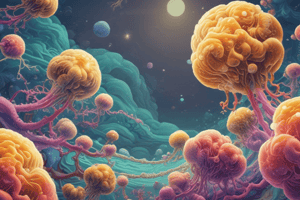Podcast
Questions and Answers
What color pigment is produced by Staphylococcus aureus?
What color pigment is produced by Staphylococcus aureus?
- Lemon yellow
- Porcelain white
- Golden yellow (correct)
- Jet black
Staphylococcus species are motile organisms.
Staphylococcus species are motile organisms.
False (B)
What is the Gram stain result for Staphylococcus species?
What is the Gram stain result for Staphylococcus species?
Gram positive
Which of the following Staphylococcus species is known as a human pathogen?
Which of the following Staphylococcus species is known as a human pathogen?
What is a coagulase test used for?
What is a coagulase test used for?
What is the main virulence factor associated with Staphylococcus aureus that can lead to vomiting?
What is the main virulence factor associated with Staphylococcus aureus that can lead to vomiting?
Staphylococcus aureus is a __________-hemolytic organism.
Staphylococcus aureus is a __________-hemolytic organism.
Which of the following is resistant to gastric acid?
Which of the following is resistant to gastric acid?
What is the appearance of Staphylococcus colonies when incubated for 18-24 hours?
What is the appearance of Staphylococcus colonies when incubated for 18-24 hours?
Staphylococcus saprophyticus is primarily associated with hospital-acquired infections.
Staphylococcus saprophyticus is primarily associated with hospital-acquired infections.
Flashcards are hidden until you start studying
Study Notes
Staphylococcus
- Spherical, non-motile bacteria that form grape-like clusters
- Gram-positive cocci
- Catalase positive
- Facultative anaerobes
- Normal inhabitants of skin and mucous membranes
- Can ferment glucose except S. saprophyticus
Staphylococcus aureus
- Primary pathogen of the genus
- Found in anterior nares of 20-30% of humans
- Produces superficial to systemic infections
- Can produce various virulence factors, including toxins and enzymes
Staphylococcus aureus Virulence Factors
- Enterotoxins: Heat-stable exotoxins that cause food poisoning and diarrhea
- Toxins A-E and G-I (eight total)
- Toxins A, B, and D are the most common causes of food poisoning
- Toxins B, C, and sometimes G and I are associated with toxic shock
- TSST-1 (toxin F): A superantigen that causes toxic shock syndrome
- Associated with tampon use
- Produced by phage group 1
- Majority of cases of menstruating-associated TSS are due to TSST-1
- Exfoliative toxins (epidermolytic toxins): Cause sloughing of the skin and are associated with:
- Scalded skin syndrome (SSS) or Ritter’s disease
- Bullous impetigo
- γ-Hemolysin (Leukocidins): Destroy leukocytes (white blood cells)
Coagulase Test
- Used to differentiate Staphylococcus species
- Enzyme coagulase produced by some Staphylococci
- Coagulase positive Staphylococci form clots in plasma
- Coagulase negative Staphylococci do not form clots
Coagulase Positive Staphylococci
- S. aureus: Human pathogen
- S. delphini, S. intermedius, S. hyicus, S. schleiferi: Animal pathogens
Coagulase Negative Staphylococci
- S. epidermidis: Hospital-acquired infections
- S. saprophyticus: UTIs in young, sexually active females
- S. haemolyticus: Infections in wounds, septicemia, UTIs, and native valve infections
Micrococcus
- Micrococcus luteus: Non-pathogenic
- Gram-positive
- Catalase positive
- Coagulase negative
General Characteristics of Staphylococci
- Morphology: Creamy, white, or light gold colonies. Some produce β-hemolysis
- Appearance: Buttery looking after incubation for 18-24 hours
- Other Characteristics: Non-motile, non-spore forming, non-encapsulated
- Aerobic or Facultative Anaerobic: One exception is S. saccharolyticus (obligate anaerobe)
Media for Growing Staphylococci
- Mannitol Salt agar (MSA): Golden yellow pigments produced by some Staphylococci
- K tellurite medium: Jet-black colonies
- Blood Agar Plate (BAP): Beta-hemolytic activity visible
Studying That Suits You
Use AI to generate personalized quizzes and flashcards to suit your learning preferences.





